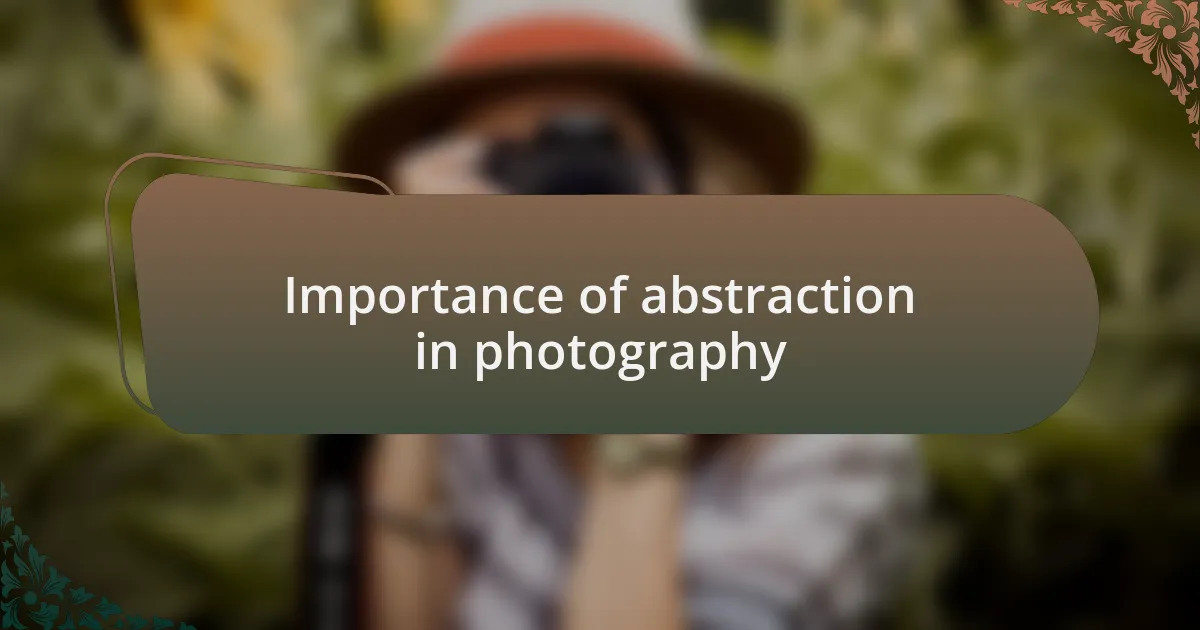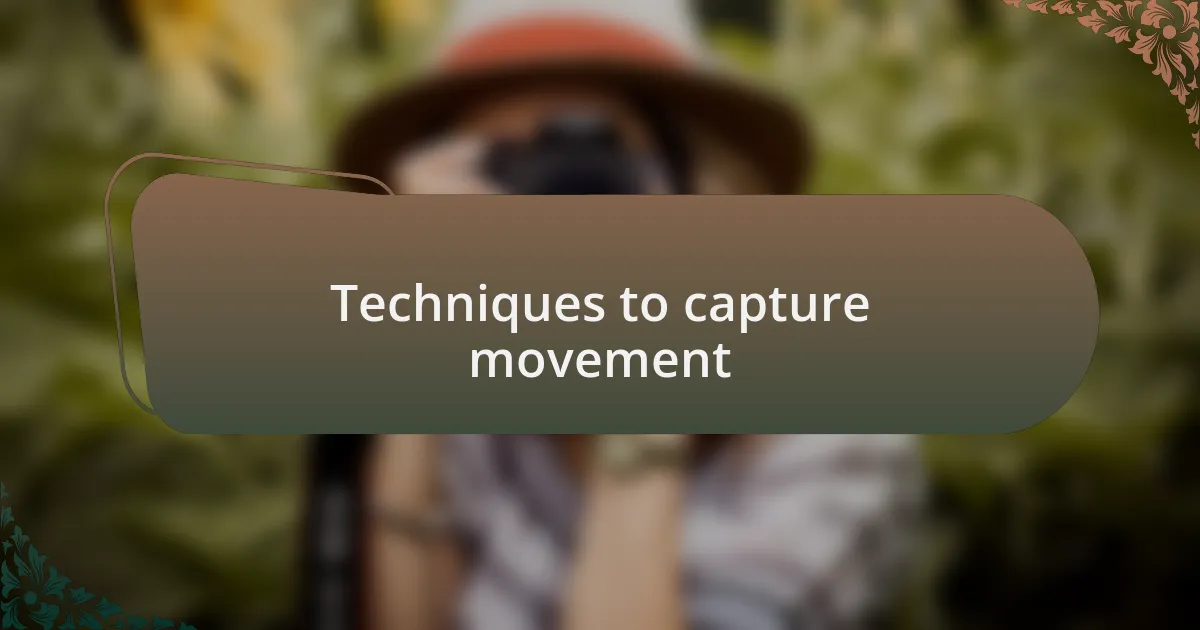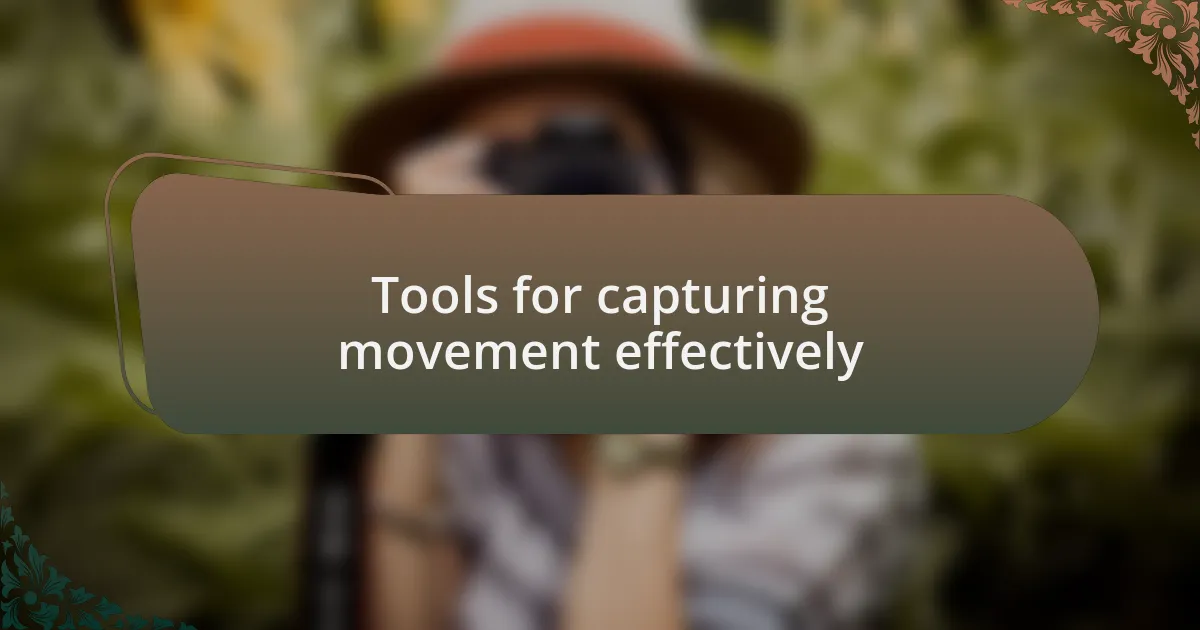Key takeaways:
- Movement in photography conveys emotion and storytelling, utilizing techniques like panning and slow shutter speeds to capture a dynamic sense of motion.
- Abstraction in photography enhances viewer imagination, allowing deeper emotional connections through non-literal representation.
- Tools such as versatile cameras and appropriate lenses, combined with techniques like intentional camera movement, significantly impact the portrayal of movement in images.
- Capturing emotion intertwined with movement transforms photographs into powerful expressions of human experience and resilience.

Understanding movement in photography
Movement in photography is more than just a technique; it’s a feeling that I often strive to capture. I remember one instance while photographing dancers in motion. The way their bodies twisted and turned created a dynamic narrative that I felt compelled to convey in a single frame. Isn’t it fascinating how a fleeting moment can evoke such emotion?
When I shoot, I often ask myself how I can make the viewer feel the rush of movement as if they are part of the scene. Techniques like panning or using slower shutter speeds can create a sense of motion, allowing the subject to dance within the frame. One of my favorite photos came from a busy street corner where I intentionally blurred the passing cars, contrasting them with a sharp focus on a static figure waiting. This interplay of movement and stillness tells a story that words simply cannot capture.
Understanding movement also involves being aware of the environment and how it influences the subjects I choose. For example, during a recent outdoor shoot at a bustling market, the vibrant colors and rhythmic patterns of people moving about enhanced the sense of activity in my photos. How can we, as photographers, better harness these elements? I believe that by observing and engaging deeply with our surroundings, we can discover ways to encapsulate the essence of movement, inviting our viewers on a journey through our lens.

Importance of abstraction in photography
The beauty of abstraction in photography lies in its ability to transcend reality. I recall a time when I framed an image of rippling water under a bridge. The water’s surface became a canvas of colors and shapes, allowing viewers to immerse themselves in the emotion of the scene rather than its literal representation. It’s intriguing how an abstract photograph can spark imagination, inviting viewers to ponder what lies beyond the obvious.
Abstraction serves as a powerful tool for storytelling. I once captured the blurred outline of a figure walking through a misty landscape, swathed in soft hues that evoked nostalgia. This image didn’t present a clear narrative, yet it stirred memories and feelings in those who viewed it, making them ponder their own journeys. Can abstraction be the key to evoking deeper connections with our audience? I believe it often is, as it removes the constraints of literal interpretation.
Furthermore, embracing abstraction allows us to explore emotions in ways that straightforward imagery cannot. For instance, when photographing autumn leaves swirling in the wind, I could convey the fleeting nature of time and change. The resulting image, though not explicitly clear in subject matter, resonated with the bittersweet feelings of transition. How often do we overlook the power of suggestion in our work? I believe that by leaning into abstraction, we can create art that truly speaks to the collective human experience.

Techniques to capture movement
Capturing movement in abstract photography requires techniques that allow us to convey motion without clear subject definition. One effective method I’ve used is intentional camera movement (ICM), where I move the camera while the shutter is open to create a fluid effect. I remember photographing a bustling cityscape at dusk; as I swirled the camera, the lights became streaks of color, emphasizing the energy of the city while obscuring the exact details of what lay beyond.
Another technique is using a slower shutter speed to create blur, which emphasizes the sense of motion. In one instance, I shot a cyclist speeding through a park, allowing the background to become a soft wash of greens and browns while the cyclist remained a faint blur. This technique invites viewers to feel the speed and thrill of the moment rather than focus on the cyclist’s likeness—what a powerful way to draw people into the experience!
I also find that experimenting with panning can bring movement into focus in a captivating way. By following a moving subject with a steady hand, I’ve captured images where the subject is sharp while the background streaks past in a whirl. In one photograph, a dancer twirling in a studio left trails of her movement behind, as if her emotion lingered in the air. How do we convey such ephemeral beauty in our still images? For me, these techniques not only capture movement but evoke the fleeting nature of life itself, creating a connection that resonates deeply with viewers.

Tools for capturing movement effectively
When it comes to tools for capturing movement effectively, I always emphasize the importance of having a versatile camera. A model with a fast autofocus system is crucial for snapping those fleeting moments. I remember once using a DSLR with advanced tracking capabilities while shooting a skateboarder in mid-air. The camera’s ability to follow the subject allowed me to freeze the action at just the right moment, capturing the thrill and energy of the trick with unparalleled clarity.
Additionally, selecting the right lens can dramatically influence how movement is portrayed. A telephoto lens, for instance, can compress distances, making it possible to capture action from afar while retaining detail. I had a memorable experience at a track event where, from the sidelines, I used a 70-200mm lens. The results were astounding—the athletes appeared larger than life, their movements stark against the blurred background. It’s fascinating how the choice of lens can change the emotional impact of an image.
Don’t underestimate the power of filters, either. Neutral density (ND) filters are excellent for slowing down your shutter speed even in bright light. I once spent an afternoon at a busy beach with an ND filter, creating beautiful long-exposure shots of waves crashing. The results were ethereal, with the water appearing like silk flowing around rocks, which perfectly conveyed the constant movement and rhythm of nature. Have you ever thought about how small adjustments in your setup can transform your vision into something magical?

Capturing emotion through movement
Movement in photography is not just about capturing action; it’s about evoking emotion. I remember a summer evening at a dance performance where the energy was palpable. As dancers moved gracefully across the stage, I focused on their expressions and movements, highlighting the sheer joy and passion of their art. The frame I took, with a blur of motion emphasizing their fluidity, resonated with the audience, conveying emotion beyond what words could express.
In another instance, I was photographing a child running through a field, her laughter mingling with the wind. To capture that moment, I chose a slower shutter speed, allowing her movements to create a beautiful trail behind her. It was as if the photograph itself was filled with the essence of joy and freedom. Have you ever felt that magic when an image portrays not just a moment but a feeling?
The relationship between movement and emotion is intricate. When I photograph athletes in motion, I often seek to encapsulate the determination etched on their faces as they push their limits. That moment of struggle, captured as they sprint or leap, tells a story of resilience. Each shot becomes an emotional journey, inviting viewers to share in the triumph of human spirit. Isn’t it incredible how a single image can evoke such complex feelings?